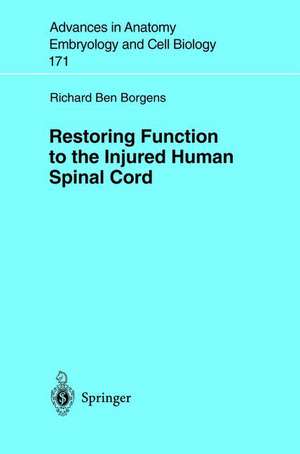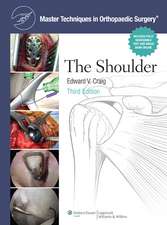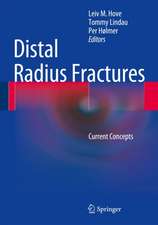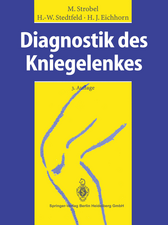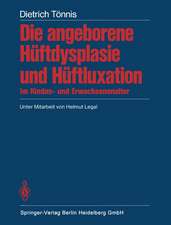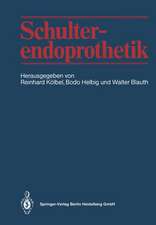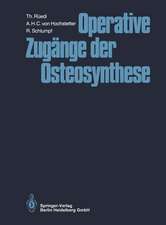Restoring Function to the Injured Human Spinal Cord: Advances in Anatomy, Embryology and Cell Biology, cartea 171
Autor Richard B. Borgens Ilustrat de K.J. Harringtonen Limba Engleză Paperback – 17 apr 2003
Din seria Advances in Anatomy, Embryology and Cell Biology
- 5%
 Preț: 1146.33 lei
Preț: 1146.33 lei - 5%
 Preț: 721.19 lei
Preț: 721.19 lei - 15%
 Preț: 637.13 lei
Preț: 637.13 lei -
 Preț: 381.81 lei
Preț: 381.81 lei - 15%
 Preț: 644.95 lei
Preț: 644.95 lei - 5%
 Preț: 1025.16 lei
Preț: 1025.16 lei - 15%
 Preț: 689.97 lei
Preț: 689.97 lei - 15%
 Preț: 577.07 lei
Preț: 577.07 lei - 15%
 Preț: 580.36 lei
Preț: 580.36 lei - 5%
 Preț: 393.51 lei
Preț: 393.51 lei -
 Preț: 408.66 lei
Preț: 408.66 lei -
![Die Schlüpfdrüse der Geburtshelferkröte (Alytes o. obstetricans [LAURENTI]) und anderer Froschlurche](https://i4.books-express.ro/bs/9783662239742/die-schluepfdruese-der-geburtshelferkroete-alytes-o-obstetricans-laurenti-und-anderer-froschlurche.jpg) Preț: 408.27 lei
Preț: 408.27 lei - 5%
 Preț: 1090.61 lei
Preț: 1090.61 lei - 5%
 Preț: 705.11 lei
Preț: 705.11 lei - 5%
 Preț: 706.04 lei
Preț: 706.04 lei - 5%
 Preț: 357.61 lei
Preț: 357.61 lei - 5%
 Preț: 704.59 lei
Preț: 704.59 lei - 5%
 Preț: 705.11 lei
Preț: 705.11 lei - 5%
 Preț: 359.42 lei
Preț: 359.42 lei - 5%
 Preț: 711.52 lei
Preț: 711.52 lei - 15%
 Preț: 635.47 lei
Preț: 635.47 lei - 15%
 Preț: 631.72 lei
Preț: 631.72 lei - 15%
 Preț: 633.35 lei
Preț: 633.35 lei - 15%
 Preț: 632.37 lei
Preț: 632.37 lei - 5%
 Preț: 706.60 lei
Preț: 706.60 lei - 15%
 Preț: 631.07 lei
Preț: 631.07 lei - 5%
 Preț: 707.13 lei
Preț: 707.13 lei - 5%
 Preț: 707.33 lei
Preț: 707.33 lei - 5%
 Preț: 359.60 lei
Preț: 359.60 lei - 5%
 Preț: 707.69 lei
Preț: 707.69 lei - 5%
 Preț: 707.13 lei
Preț: 707.13 lei - 5%
 Preț: 708.06 lei
Preț: 708.06 lei - 5%
 Preț: 706.41 lei
Preț: 706.41 lei - 5%
 Preț: 708.78 lei
Preț: 708.78 lei - 5%
 Preț: 705.68 lei
Preț: 705.68 lei - 5%
 Preț: 705.11 lei
Preț: 705.11 lei - 5%
 Preț: 706.77 lei
Preț: 706.77 lei - 15%
 Preț: 635.15 lei
Preț: 635.15 lei - 15%
 Preț: 631.07 lei
Preț: 631.07 lei - 5%
 Preț: 706.77 lei
Preț: 706.77 lei - 5%
 Preț: 706.04 lei
Preț: 706.04 lei - 5%
 Preț: 710.79 lei
Preț: 710.79 lei - 5%
 Preț: 705.32 lei
Preț: 705.32 lei - 15%
 Preț: 633.19 lei
Preț: 633.19 lei - 15%
 Preț: 629.09 lei
Preț: 629.09 lei - 15%
 Preț: 633.53 lei
Preț: 633.53 lei - 15%
 Preț: 632.70 lei
Preț: 632.70 lei - 15%
 Preț: 633.68 lei
Preț: 633.68 lei - 18%
 Preț: 773.72 lei
Preț: 773.72 lei - 15%
 Preț: 630.43 lei
Preț: 630.43 lei
Preț: 366.70 lei
Preț vechi: 386.00 lei
-5% Nou
Puncte Express: 550
Preț estimativ în valută:
70.17€ • 73.52$ • 58.01£
70.17€ • 73.52$ • 58.01£
Carte tipărită la comandă
Livrare economică 12-26 aprilie
Preluare comenzi: 021 569.72.76
Specificații
ISBN-13: 9783540443674
ISBN-10: 3540443673
Pagini: 180
Ilustrații: XVI, 161 p. 61 illus., 30 illus. in color.
Dimensiuni: 155 x 235 x 9 mm
Greutate: 0.37 kg
Ediția:Softcover reprint of the original 1st ed. 2003
Editura: Springer Berlin, Heidelberg
Colecția Springer
Seria Advances in Anatomy, Embryology and Cell Biology
Locul publicării:Berlin, Heidelberg, Germany
ISBN-10: 3540443673
Pagini: 180
Ilustrații: XVI, 161 p. 61 illus., 30 illus. in color.
Dimensiuni: 155 x 235 x 9 mm
Greutate: 0.37 kg
Ediția:Softcover reprint of the original 1st ed. 2003
Editura: Springer Berlin, Heidelberg
Colecția Springer
Seria Advances in Anatomy, Embryology and Cell Biology
Locul publicării:Berlin, Heidelberg, Germany
Public țintă
ResearchCuprins
1 A Brief Primer on Spinal Cord Injury.- 1.1 Epidemiology.- 2 The Behavioral Catastrophe is Rooted in Injury to White Matter.- 2.1 The Ground Plan of the Spinal Cord.- 2.2 Characteristics of SCI.- 3 The Scar As a Barrier To Regeneration.- 3.1 Inhibitory Molecules.- 3.2 Other Cells Important to SCI.- 4 Treating the Acute and Chronic Injury: Historical Perspective.- 5 Concerning Behavioral Models for Spinal Cord Injury in Animals.- 5.1 When Walking is Not Walking.- 5.2 Injuring the Cord and Probing its Anatomy.- 6 Axonal Regeneration.- 6.1 Collateral Sprouting.- 6.2 A Neurons Journey: Integrating Guidance Cues.- 7 Treatment Possibilities of the New Biology.- 7.1 Restoration.- 7.2 Repair.- 7.3 Regeneration.- 8 Biologically Produced Electrical Fields: Physiology Spoken Here.- 8.1 Concerning Naturally Produced DC Voltage Gradients.- 8.2 The Skin Battery and Electric Embryos.- 9 Endogenous Voltages and the Reaction of the Neuron to Injury.- 10 The Responses of Isolated Nerve Fibers in Culture to Applied DC Voltages.- 10.1 Historical Perspective.- 10.2 Galvanotaxis: Rules and Trends.- 10.3 Extracellular Voltages and the Choices Neurons Make.- 11 Enhancing Spinal Cord Regeneration in situ with Applied Electric Fields.- 11.1 The Control of Regeneration of Nerve Fibers in the Fish Spinal Cord by Applied Electric Fields.- 11.2 The Anatomy of Regeneration of Spinal Cord Nerve Fibers in the Laboratory Rat and Guinea Pig.- 11.3 Guiding Spinal Cord Axons into Rubber Tubes with Applied Voltages.- 11.4 Anatomical Responses to Applied Voltages by Non-Neuronal Cells Important To Spinal Cord Injury: The Macrophage.- 12 Recovery of the CTM Reflex in Spinal Injured Guinea Pigs after Exposure To Applied Extracellular Voltages.- 13 From a Laboratory Tool To a Clinical Application.- 14 Naturally Occurring Spinal Injury in the Dog as a Model for Man.- 14.1 Clinical Trials of OFS in the Paraplegic Dog.- 14.2 Recovery of Function in Paraplegic Dogs.- 14.3 Combined Results of Both Clinical Trials of OFS.- 15 Sealing the Breach in Cell Membranes with Hydrophilic Polymers.- 15.1 Introduction.- 15.2 Spinal Cord Fusion: Proof of Concept.- 15.3 Repairing a Crush Injury with PEG.- 16 Recovery of Behavioral and Physiological Function in vivo.- 16.1 Polymer Injection Into the Blood Supply.- 16.2 Safety of Intravenous Polyethylene Glycol (PEG).- 17 PEG Application in Clinical Cases of Canine Paraplegia.- 17.1 The Amphiphilic Triblock Copolymers.- 18 Conclusion.- References.
Textul de pe ultima copertă
Of catastrophic traumas to the human body, spinal cord injury (SCI) has least benefited from innovations arising from the new biology. Since after WW II, the "standard of care" for SCI has changed little. The controversial use of high dosages of steroids has provided only modest benefit to patients – but not without the enhanced risk of mortality. Novel therapies arising form biochemistry and genetics have not materialized in over 15 years, and are unlikely to in the author’s opinion. Instead, appreciation of biophysics and cell physiology in controlling nerve injury, growth, regeneration, and function has produced innovative clinical approaches now in testing in human spinal cord injury.
